Click on the top left picture and scroll through the story by clicking right.
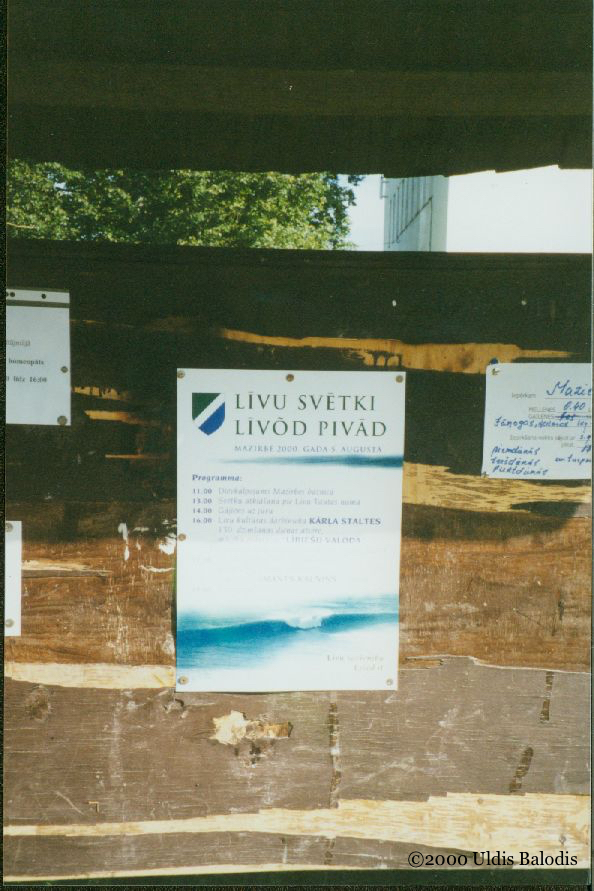
It was the first week of August and the Livonian youth camp was drawing to a close. We spent our final night together watching the sun set at Īra beach down the coast, singing songs and cooking sausages over the open flame of our campfire. The next day Irē began to fill with outsiders. The fields were suddenly packed with parked cars and an ocean of people streamed through the town. Listening to them speak, I soon noticed that not only were these people not Livonian (and really, what a surprise that would’ve been, finding some unknown mass of Livonians suddenly descending on their ancient homeland) they were also not Latvian. The Livonian Festival apparently attracted a great deal of Estonians along with a smaller number of people from other countries. Estonian and Livonian are not mutually intelligible, but they share many similarities. For a moment I wondered, whether this is the closest I would ever get to knowing what the coast was like when Livonian was still spoken by a majority of its residents.
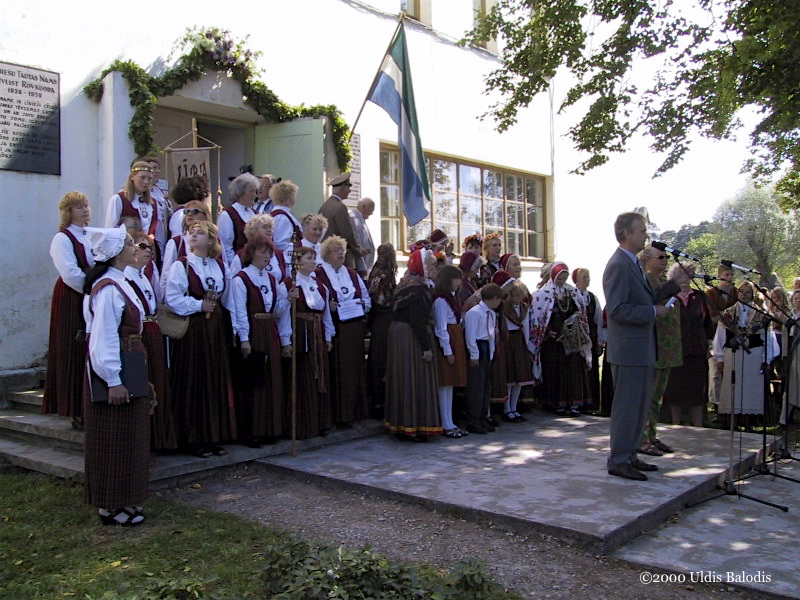
The Livonian Festival was a day filled with choral and dance performances, some Livonian, others from Latvia and neighboring countries. Along with the performances, a litany of dignitaries spoke representing the Latvian government and those of the Finnic-speaking nations of Europe. In this picture, a Livonian folk ensemble stands on the steps of the National Hall. The entrance adorned with a garland, a Livonian flag gently flutters overhead.
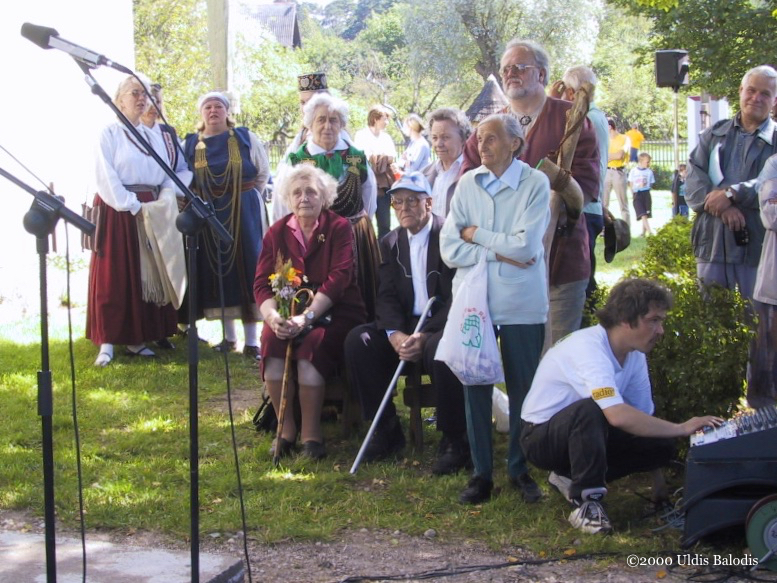
Today there are less than two hundred individuals in Latvia that identify themselves as Livonian. Less than ten are native speakers of the language. Most of them are elderly. As I listened to the folk ensemble perform, I turned my attention to the audience. There was Poulīn, in the red dress, perhaps the most famed native speaker. I knew her, but surrounding her were a number of other people, other speakers of the language. Usually, it seems like nations are large undifferentiated masses of people. But just a few feet away from me was the core of an entire nation, gathered together under the shadow of a single tree.
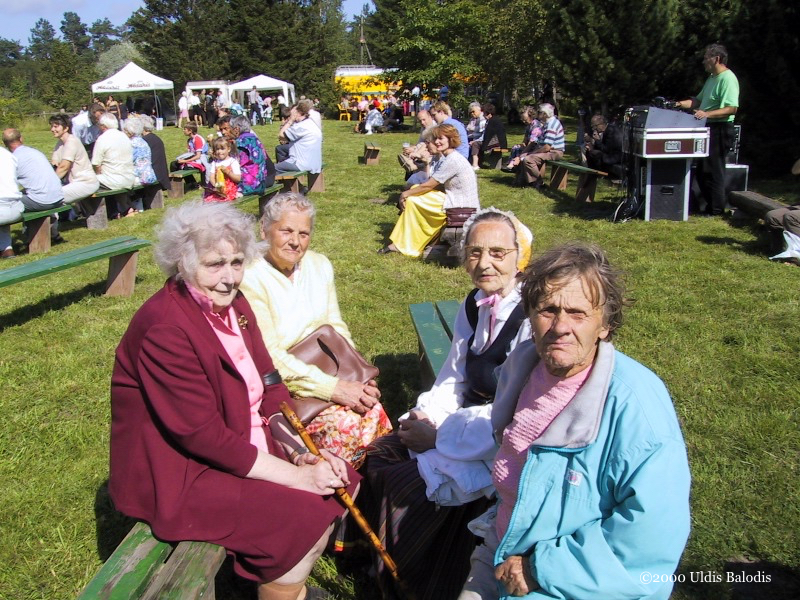
The choral and dance performances had ended for the time being. The crowd began to drift away from the National Hall at the center of town. Many flocked to the concession stands set up throughout the community. As I walked away, I saw Poulīn. I had gotten to know her during the course of the last few weeks. I figured I was probably more excited to see her than she was to see me, after all she was one of a kind, and I was one of many flocking to this place, eager to hear her stories and her language. But in her typical style, she recognized me and invited me to sit down with her and the other ladies in this picture. I listened to them speak, and I understood that by sheer chance I had come to be part of a very special conversation. The language these women were conversing in was Livonian. I could hardly believe it, and they kindly allowed me to speak with them, using the broken Livonian I had taught myself over the course of the past months and years. I would later think how strange it was that in that moment in the entire world, this was likely the only conversation taking place in this language. I did not leave the coast that summer a fluent speaker, but the knowledge I did possess was due to these few precious chances I had to actually use it thanks to the generosity of Poulīn and the other speakers I had met.
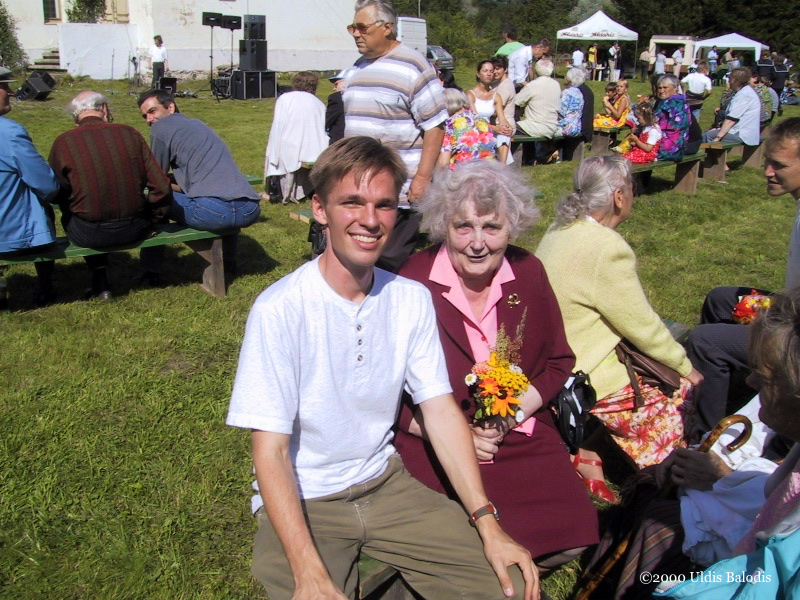
After speaking with the ladies for a while, I took the opportunity to have a picture taken sitting next to Poulīn.
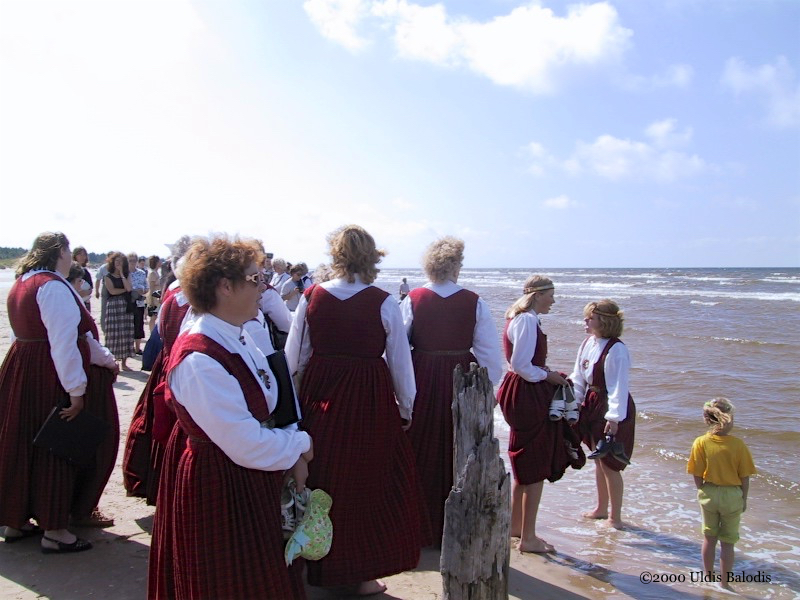
After the end of the day’s performances, the festival moved to the beach. A wreath was placed in the ocean as an offering to Mierjemā, Ocean Mother. The sun shone brightly that day. Poulīn said some things in Livonian as the breeze fluttered the costumes of those in traditional dress. In the days following the festival I would hike with several of the teachers from the camp through the forests and villages of the coast. Several kilometers north of Irē we would find the wreath washed up on the shore. I laughed, not thinking that it really took away from the beauty of the moment when the wreath had been offered to the ocean. Rather it was like peering behind the curtain and seeing into the true nature of things. All of us have probably released helium balloons into the air or dropped bottles with messages into the ocean, but how many of us have seen where they end up. I was lucky to see the full cycle, to see what Mierjemā was doing with all those wreaths that had been sent to her over the years.
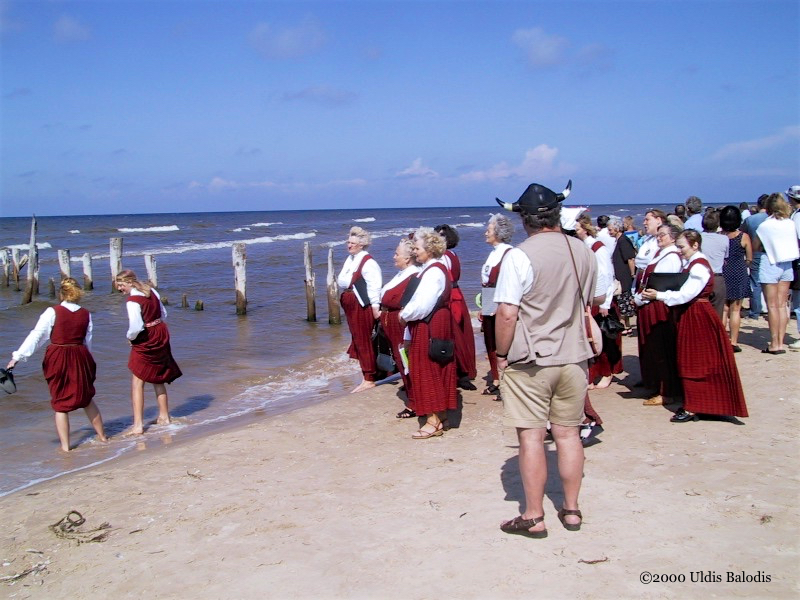
Members of a Livonian folk ensemble step gingerly into the crisp waters of the Baltic. A mysterious horned stranger stands in the foreground.
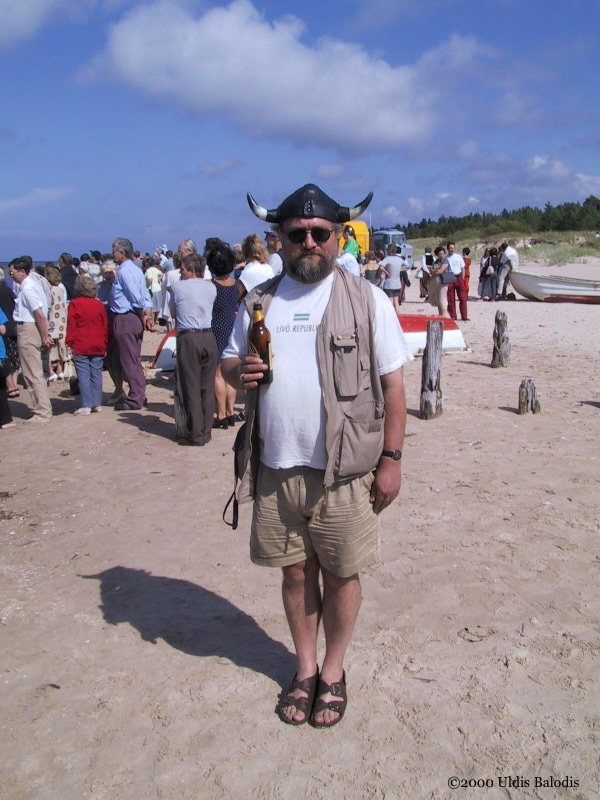
I never really got to know this man. I saw him walking around the festival, and seeing him on the beach again, I took the opportunity to take his picture, which he gladly agreed to. We didn’t share a common language, so I never learned the significance of the Viking helmet. I wanted to ask him where he got his shirt. It had a Livonian flag on it with the words Līvõ Republik (Livonian Republic). It seemed like a neat souvenir, but it must have been from an earlier year, as I saw none for sale when I was there. Luckily, a friend of mine was able to get me one of the posters advertising the festival, which was nice too.
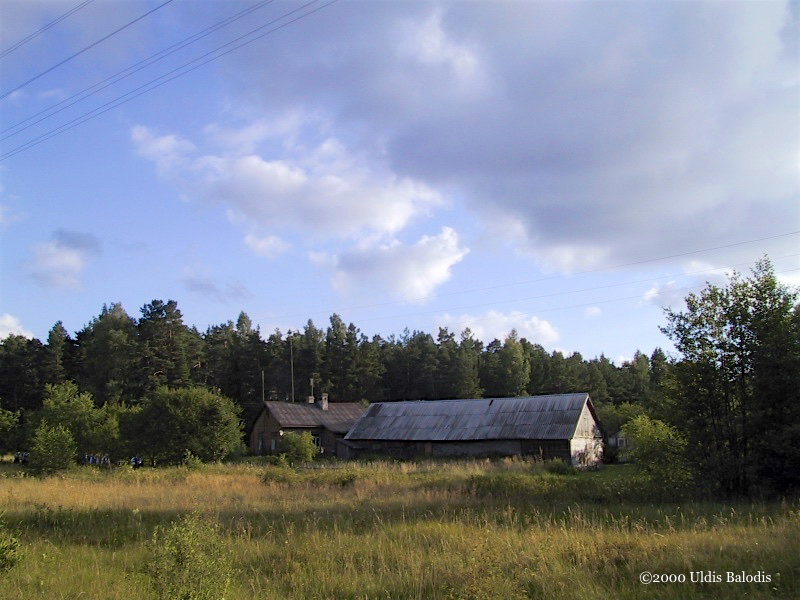
The festival was coming to an end, and I still had to pack a few things. I was spending the night in Pizā with some of the teachers from the camp. Tomorrow we would start on a three-day hike along the coast, exploring each of the Livonian towns along our way. Walking back to my room, the sun was already hanging low in the sky. The world colored in soft hues by the approaching evening.
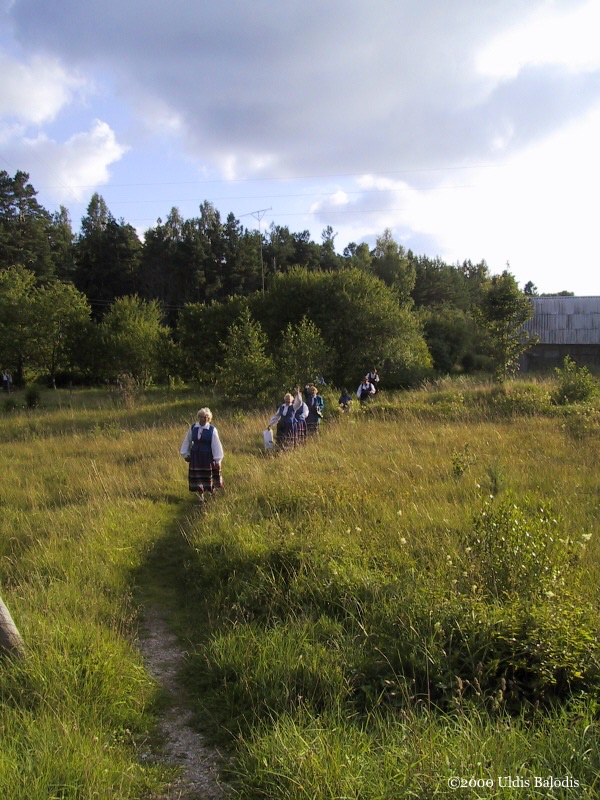
As I turned and looked across the field, I saw a group of folk dancers walking towards me. We met halfway, and thinking they were Latvian, I greeted them in my native language. They smiled and answered me in Estonian. I tried English, they tried Russian. Again no luck. We stood there smiling, exuding untold amounts of goodwill, without being able to communicate it. Suddenly, I had a crazy idea. I addressed them in Livonian. It’s all I could think to do at that moment, and it didn’t really seem like such a bad idea. After all, Livonian and Estonian are fairly closely related, and I had always heard that speakers of these languages could understand each other. Estonian-speaking fishermen from Saaremaa, to the north, had long been interacting with the Livonian-speaking fishermen of the coast. The ladies looked at each other, and answered me back in what seemed like a very measured Estonian, geared towards my understanding. All of a sudden we were speaking to each other, transcending the boundaries of language. It was a sublime moment. A few weeks later, I would try this trick again, at a newsstand in Tartu. But this time it didn’t work quite as well. The woman working there gave me a sort of bewildered wide-eyed stare that could have conveyed many things, but I felt understanding was probably not one of them.